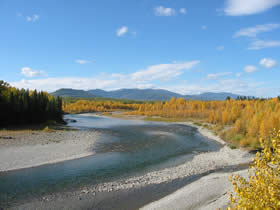
Consumes Guide to Digital
Cameras
Megapixels & Resolution

 |
Consumes Guide to Digital
Cameras
|
 |
| Home > Digital Photography > A Consumers Guide > Megapixels & Resolution | Search Site |
Digital Photography
|
What Are Megapixels & Why Should
I Care?
|
 |
| The
North Fork Flathead River in Montana Photo Use Guidelines |
So, what is a megapixel? You read about it and see the term everywhere. Yet, did anyone ever bother to explain what the heck a megapixel is? I didn’t think so. So, let’s start at the beginning. A digital camera captures an image through a sensor called a CCD. This sensor has light sensing dots called pixels. The actual resolution of a camera is the total number of pixels that are located on the CCD sensor. Resolutions of digital cameras range from (0.3 megapixels to 20+ megapixels). A megapixel is just a way of expressing how many pixels are on the CCD sensor, in millions. Thus, a 2-megapixel camera has about 2 million pixels on the cameras CCD sensor. Simple, huh?
So, why should you care? Now, that is a good question. Over the past few years, there has been a “megapixel race” among digital cameras. When digital cameras were first introduced, a 3-megapixel digital camera was a powerhorse. Today, you can’t even find the things on ebay.
By and large, this “megapixel race” has been a good thing. However, like everything else in life, all good things eventually reach the stage of overkill. Today, while the megapixel race continues, few photographers really need “all those megapixels.” Indeed, all those “extra megapixels” can actually create a few problems, such as hogging up space on your hard drive and causing a slow transfer of image files between your camera and computer. In the end, while some megapixels are good for you, having too many megapixels can be irksome and bothersome.
Let’s put megapixels to work in real life…like where you and I live. The more megapixels a digital camera has, the greater resolution the camera has and, thus, the larger the photograph will be. Thus, if you forget everything else on this page, remember this.
More Megapixels = Larger Images
But, how big of an image? Now, that’s the key question, isn’t it. See, this is where the camera companies have consumers coming and going. For 99+% of all consumer photography uses, you do NOT need a camera that has more than 10-megapixels. Indeed, even an 6 or 8-megapixel digital camera will handle virtually all of a casual photographers needs. How so? Well, take a look at the chart below. This chart shows you the minimum megapixels needed to print a digital image at photo quality for various sized prints.
1-megapixels : 4x6 inches
2-megapixels : 5x7 inches
4-megapixels : 8x10 inches
6-megapixels : 11x14 inches
8-megapixels : 16x20 inches
Now, what is “photo quality” to one person may not be “photo quality” for another person. For this reason, let’s use the “industry standard” resolution of the publishing industry (such as magazines). The publishing industry usually prints up photos with a resolution of 300 dots per inch (dpi). This is exceptionally high quality, so high, in fact, that few people will ever notice a difference between a 250 dpi photo and a 300 dpi photo. Yet, even by using this standard, you can still print an 8-megapixel image to a size of 8 x 11 inches. So, unless you plan on printing out your photos at a size larger than 8 x 11 inches at the absolute, highest quality on the absolute, highest quality paper, using the absolute highest quality photo printer…you are unlikely to EVER need a digital camera that has more than 8-megapixels.
Still, there is one advantage to having a “few spare megapixels” lying around. And that advantage is that by having some spare megapixels you’ll have some freedom to crop and edit photos and still print them out at a large size. By and large, a 8-megapixel camera has plenty of spare megapixels lying around. However, if you do plan on printing photo quality prints of 16x20 inches (or 8x11 prints at the absolute highest quality setting of 300dpi), then having a 10-megapixel digital camera might prove useful.
If you haven’t figured it out, I recommend an 8-megapixel digital camera. For virtually all consumer uses, it’s all you’ll ever need. And truthfully, if you plan to print your images at larger sizes, then you shouldn’t be buying a “point and shoot” digital camera anyways. Instead, for poster size prints, you’ll want a digital SLR camera instead, as the sharpness (assuming you use a quality lens) will provide superior prints at large sizes. Get Informationa and Prices for Canon Point & Shoot Digital Cameras at Amazon.
Well, we now know what kind of camera to get. And we know how many megapixels we want in our camera. So, let’s go to the next step…making sure we have a few key features on our camera.
Next Page : Get a Useful Camera!
|
Copyright 2002-2018 |
| Montana Web Cams | Montana Information | Fly Fishing Gear | Fishing Boats | About | Contact Us | Advertising Information | Privacy Policy |